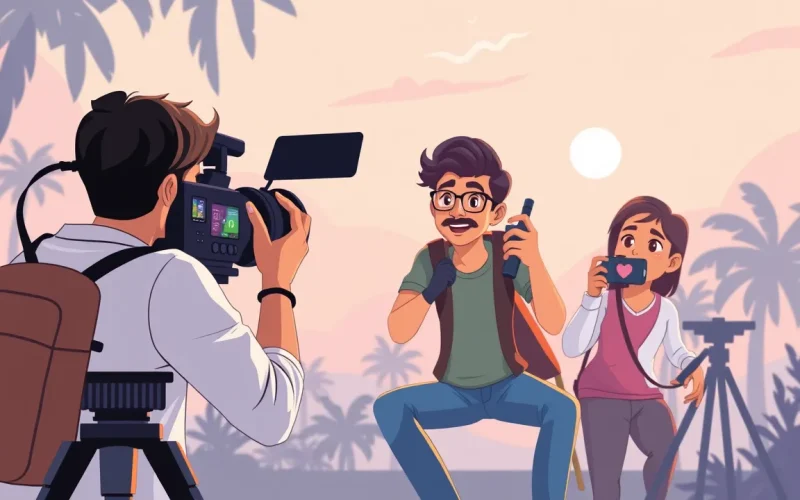By Sarthak Goswami
When Prime Minister Narendra Modi met India’s top creators at the National Creators Awards in New Delhi’s Bharat Mandapam, it was more than a photo-op.
It was a moment of national recognition for a growing economic force: the Indian creator economy.
From classrooms to kitchens, reels to retweets — content creators are reshaping entertainment and building livelihoods.
RedSeer Strategy Consultants estimates that India had over 8 million creators in 2023.
The country’s creator economy is projected to reach $500 million by 2025.
But what does it take to build a career in this space? Who really makes money? And is it sustainable?
To understand the human side of this booming industry, Invezz spoke to creators from across platforms — YouTube, Instagram, and X — along with one educator guiding thousands on how to thrive in the digital world.
Their journeys paint a picture that’s equal parts opportunity and uncertainty.
“It’s not a job, it’s a bet”: YouTuber Padhle Akshay
22-year-old Akshay, known online as Padhle Akshay, runs educational channels with over 1.3 million subscribers.
But success didn’t come easy. “I started in 2020 while still in Class 10. My first earnings? ₹11,000 after eight months. My first sponsor paid ₹500,” he recalls.
The breakthrough came with a simple but clever idea — showing students exactly which lines were deleted in the newly revised CBSE syllabus.
“Everyone was just reading out the new syllabus. I visualised the change. That video went viral,” he says.
Even after hitting a million subscribers, the pressure never eased. “You get paid for reach and views, not your subscriber count,” he says.
“Now even Shorts are evolving — attention spans are dropping. Your edit speed, hook, everything needs to adapt.”
When it comes to money, Akshay breaks down the reality: AdSense income is “just enough for basics,” affiliate links are a gamble, and real revenue comes from sponsorships, digital products, and community monetisation. “You need to treat it like a business, not a hobby.”
His view on the future? “This is not a bubble. As long as Meta and YouTube are here, creators will thrive. Even IITians are turning creators.”
A report by Influencer.in supports this — YouTube remains the top platform for monetisation, preferred by 61% of Indian creators.
Yet, only 0.5% of creators cross the ₹1 lakh monthly mark — showing how steep the climb really is.
“Don’t quit your job just yet”: Performer Aaditya Preeti
Aaditya Preeti, an actor with over 470K followers on Instagram, prefers the label “performer” over “creator.”
He has done ads for brands like Vida EV and Sunfeast and built his social following through skits — but he’s wary of creator life being romanticised.
“Content creation is flexible, yes — but also extremely unstable. One month you earn well, the next? Nothing,” he says.
Despite his reach, Aaditya never relied on content full-time. “I always had a parallel path — theatre, freelancing, acting. Content is just one of the ways I perform.”
Even brand deals, he says, are not as easy as they seem. “I’m managed by an agency. They deal with the brands. I just focus on content.”
His advice? “Forget the glam. Just create. Stay consistent. Don’t chase others’ numbers.”
The boom in short-form content backs his point. Meta’s Reels Bonus Program and YouTube Shorts Fund have encouraged more creators to enter — but the income is erratic.
According to Zefmo Media, only 1 in 4 creators earn consistently through brand collaborations.
“Not all of us are making money”: X creator Vikash Yadav
Vikash Yadav, who runs the X handle @indianinfrareport, built a following of over 40,000 by focusing on India’s infrastructure — a niche rarely associated with virality.
His journey started during UPSC prep, and like many on X, his turning point came after Elon Musk’s monetisation push.
“Now I get paid every 14 days. It’s enough for pocket money, books, UPSC prep. But nothing big,” he says.
X’s monetisation pays based on engagement from verified users — and it’s inconsistent. “Some are earning thousands of dollars. Most don’t earn at all,” he says.
Paid collaborations are also selective. “You need high engagement and trust. I’ve done a few PR posts, but they’re rare.”
For Vikash, content creation remains a side hustle. “It helps, but it’s not a career — not yet.”
“Monetisation alone won’t build your career”: Jacob, mentor and creator coach
Jacob C Edmunds has over a decade of experience in content and now teaches creators how to grow online — responsibly.
With 220,000+ followers across platforms, his message is clear: this is a real career path, but not an easy one.
“AI tools have made it easy to start — but competition has exploded,” he says. “If you’re not adapting, you’ll fall behind.”
He emphasises building income streams outside of platform payouts.
“Courses, brand deals, websites — that’s how you build something sustainable. Don’t depend only on the algorithm.”
His takeaway: “Start now. Learn fast. Stay human — but don’t ignore AI. It’s a creative revolution.”
The road ahead: promise and pressure
While individual stories highlight the hustle, the macro picture shows why brands, platforms, and even the government are taking creators seriously.
The numbers below illustrate just how big the creator economy already is — and where it’s heading.
| Metric | Value | Notes | Source |
|---|---|---|---|
| Influencer marketing spend (2025) | ₹3,000–₹3,500 crore (~$360–420 M) | Rapidly growing sector fueled by FMCG and e‑commerce brands | Kofluence report |
| Annual growth rate of creator economy (CAGR) | ~25% (2024‑30) | Projected to reach ₹500 billion by 2030 from ₹125 billion in 2024 | EY report |
| Consumer spending influenced by creators (annual) | $350–400 billion | Roughly 30% of Indian consumer spend already influenced by creators | BCG report |
| Projected creator-influenced consumer spend by 2030 | $1 trillion (~₹84.5 lakh crore) | Envisioned as a major engine of digital commerce | BCG report |
According to Kalaari Capital, 200 million Indians are now part of the “passion economy” — people making a living from online content, digital art, and personal brands.
Yet the path remains unpredictable. Only a small fraction of creators earn sustainably. Most juggle multiple income streams. The glamour, as all four voices confirm, masks the grind.
But the upside? India’s creator economy is young — and growing fast.
As long as creators keep adapting — and audiences keep watching — the spotlight isn’t fading anytime soon.
(Sarthak Goswami is an intern at Invezz in New Delhi, currently pursuing a BA (Hons) in Journalism from Maharaja Agrasen College, University of Delhi. He specialises in geopolitics, the economy, and new media, and is also the founder and editor of Beats in Brief and Queats Media.)
The post Inside India’s creator economy: opportunity, hustle, and the hard truth appeared first on Invezz


